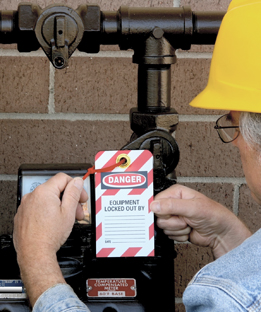Training Room 2: Keeping Safe and Healthy—Standards and Practices in an Agricultural Environment
Session 2: Electrical Safety—Standards and Practices

© Perrush/11343376/Fotolia
Electrical hazards on the farm can lead to electrocution of workers, electrical shock to livestock, and risk of fire in farm structures and farm machinery.
Common types of electrical injuries on the farm include
- shock or electrocution due to faulty wiring, damaged tools, or damaged extension cords
- shock or electrocution in damp or wet locations such as out-buildings and dairy barns
- accidental energizing of circuits or equipment while someone is performing repairs or maintenance
- equipment contact with yard wiring or high voltage (15kV or 15 000 volt) utility lines (a major concern with tall equipment such as grain augers, combines, and large tillage equipment in transport position)
Learning Target
In this session you will demonstrate your understanding of standards and practices related to electrical safety and develop safe working practices for your specific agricultural worksite. Keep the following questions in mind as you work through the material:
- How can you identify electrical hazards where you live and work?
- What is the best strategy to ensure safe working conditions when working with electricity on your agricultural worksite?
Understanding Electrical Hazards
Watch and Listen
Investigate potential electrical hazards in your home and agricultural work environments. Learn more about these hazards by exploring the following resources:
- Watch the Electricity Smarts video at the epcor.ca website.
- Read Electrical Incidents Can Be Avoided: Power Line Safety Tips to learn about the hazards of overhead and underground power lines. (Joint Utility Safety Team, Alberta)
- Find the electrical safety rules in Sample Farm Safety Plan.
(Alberta Farm Safety. Used with permission.)
Establishing Safe Working Conditions for Electricity
When electricity is being used in a working environment, it is important to be aware of the hazards and plan for safety. This can mean devising rules and setting procedures for electrical safety and sharing them with everyone in the workplace.
Safety plans should address the following issues:
- power cords
- use of circuit breakers
- grounding of equipment
- lockout/tagout procedures
- power lines (above and below ground)
- environmental hazards (corrosive/damp environments, dusty environments)
- physical damage to electrical system caused by livestock or equipment
Websites
Click on the following links to learn about the hazards introduced so far in this training room.
-
Electrical Safety on the Farm—information about safety procedures around a variety of potential electrical hazards, including circuit breakers, grounding, lockout, power lines, and damage to electrical systems

Paul Jantz/Hemera/Thinkstock
- Lockout Tagout—information about the important procedures used with equipment maintenance
Lockout means placing a lock on an electrical device to prevent the release of electricity. Locking out is used to so that equipment or machinery cannot be started up or energized when service or maintenance activities are taking place.
Tagout means that a tag is placed on a switch or other device used to turn off the machinery. This tag tells others not to start up the piece of equipment. Tagout should be used together with lockout to keep workers safe (unless the equipment cannot be locked out).From the Canadian Federation of Agriculture Fact Sheet #3 and the Alberta Government's Best Practices for the Assessment and Control of Physical Hazards.
Watch and Listen
- You've Got a Lot on the Line—cartoon explaining hazards and safety procedures of overhead power lines on the farm. This one takes a while to load. (Saskpower)
Checking In
Your Task: Create a Strategy for Safe Working Conditions for Specific Electrical Hazards
Create a strategy that would keep you and your co-workers safe when dealing with any two of the following electrical hazards. Include information about lock out/tag out procedures that would be used to communicate with fellow workers about safety when equipment is being worked on.
- power cords
- use of circuit breakers
- grounding of equipment
- power lines (above and below ground)
- environmental hazards (corrosive/damp environments, dusty environments)
- physical damage to electrical system by livestock or equipment
What To Do
- Identify the two potential electrical hazards you have chosen. Describe examples of these in your agricultural workplace of choice.
- Determine the rules/standards that need to be in place to prevent injury from the hazards you have chosen. Use the resources above to help you.
- Describe the lockout/tagout safety procedure that would be used if the electrical equipment is being worked on.
- Create a communication tool (examples: sign, poster, safety manual page) to share these standards and procedures with co-workers. This tool will help establish safe working conditions for all those in the workplace.
 How to Submit Your Work
How to Submit Your Work
Submit your tool as instructed by your teacher.